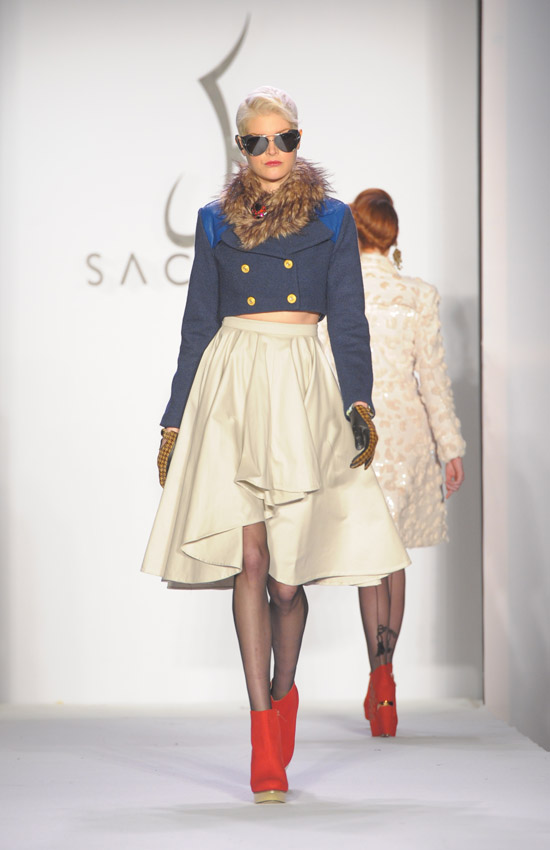A short waist- or bust-length jacket worn in the late 18th and early 19th centuries.
The Details
Fashion historian Daniel Delis Hill writes in the History of World Costume and Fashion (2011):
“Another type of women’s outerwear was an adaption of a men’s jacket called the spencer…The masculine version, which had emerged at the end of the 1700s as an English eccentricity, was cropped at the waist without a skirt or tails. Because of the high-waisted silhouette of women’s gowns, the hemline of the feminine spencer extended to just under the bosom. Variations of the spencer–some sleeveless–also were designed of lightweight wool or silk for indoor wear.” (465)
The Philadelphia Museum of Art has a girl’s spencer jacket from ca. 1800-05 (Fig. 1).
Fashion historian J. Anderson Black defines a spencer jacket in A History of Fashion (1990) as:
“A very short-waisted jacket originally worn by women in the 1790s over their Empire dresses. Later a similar style was adopted by some regiments of the army as a mess jacket.” (292)
The Los Angeles County Museum of Art has a mustard-colored spencer from ca. 1815 (Fig. 2).
Phyllis Tortora and Sara Marcketti in the Survey of Historic Costume (2015) define a spencer jacket as:
“A short jacket (worn by both men and women) that ended at the waistline for men and just under the bosom for women. Made with sleeves or sleeveless, the color usually contrasted with the rest of the costume. Spencers were worn indoors as well as out.” (316)
The Metropolitan Museum of Art has an example of a spencer (Fig. 3) that has ornamental braid like a military jacket, reflecting its menswear origins.
When describing a blue velvet spencer in their collection (Fig. 4), the Victoria and Albert Museum explained the spencer’s origins:
“Following the plain appearance of Neo-classical dress, a new decorative trend can be seen in the patterning of the gown and the embellishment of the shoulders. In order to provide warmth for lightweight gowns, jackets such as this one in blue velvet were worn. It follows the high-waisted style of the dress, but has long sleeves and a high collar. Such jackets were known as ‘spencers’. They were named after George, 2nd Earl Spencer (1758-1834), who is said to have worn short jackets without tails in the 1790s and started the fashion for them. Similar spencers for walking dress can be seen in fashion magazines of the period 1815-1825.”
Fig. 1 - Designer unknown (American). Girl's Spencer Jacket, ca. 1800-1805. Tan cotton plain weave; center back length (jacket with collar): 46.4 cm waist: 25 63.5 cm. Philadelphia: Philadelphia Museum of Art, 1927-54-3. Gift of Miss Mary E. Hagner, 1927. Source: PMA
Fig. 2 - Designer unknown (French, 1815). Woman's Spencer Jacket and Petticoat, ca. 1815. Cotton plain weave; skirt: cotton plain weave with linen net and cotton plain-weave appliqués; center back skirt length: 104.14 cm; center back spencer length: 33.02 cm. Los Angeles: Los Angeles County Museum of Art, M.2007.211.15a-b. Source: LACMA
Fig. 3 - Designer unknown (French). Jacket, 1805-15. Cotton, linen, and silk. New York: The Metropolitan Museum of Art, 1991.330. Purchase, Judith and Gerson Leiber Fund, 1991. Source: The Met
Fig. 4 - Designer unknown (British). Spencer jacket, ca. 1818. Velvet faced with satin, hand-sewn. London: The Victoria and Albert Museum, T.890-1913. Given by Messrs Harrods Ltd.. Source: V&A
Its Afterlife
Fig. 5 - Ralph Lauren (American, 1939-). Ralph Lauren Ready-to-Wear, Fall 2013. Photograph by imax tree. Source: stylecaster.com
Fig. 6 - Sachika. Sachika Ready-to-Wear, Spring 2014. Photograph by la fashion magazine. Source: modernglossy.com
References:
- Black, J. Anderson, Madge Garland, and Frances Kennett. A History of Fashion. Rev. ed. New York: Quill, 1980. http://www.worldcat.org/oclc/26606290.
- “Eighteenth-Century Clothing.” In Fashion, Costume, and Culture: Clothing, Headwear, Body Decorations, and Footwear Through the Ages, 2nd ed., edited by Sara Pendergast, Tom Pendergast, Drew D. Johnson, and Julie L. Carnagie, 537-553. Vol. 3, European Culture from The Renaissance to the Modern Era. Detroit: UXL, 2013. Gale Virtual Reference Library (accessed October 3, 2018). http://libproxy.fitsuny.edu:2540/apps/doc/CX2760000104/GVRL?u=fitsuny&sid=GVRL&xid=fce9423d.
- Hill, Daniel Delis. History of World Costume and Fashion. Upper Saddle River, NJ: Pearson Prentice Hall, 2011. http://www.worldcat.org/oclc/939043732.
- “Jacket | V&A Search the Collections.” V and A Collections, August 6, 2019. http://collections.vam.ac.uk/item/O13827.
- Tortora, Phyllis G., and Sara B. Marcketti. Survey of Historic Costume. Sixth edition. New York, NY: Fairchild Books, 2015. http://www.worldcat.org/oclc/910929404.
















